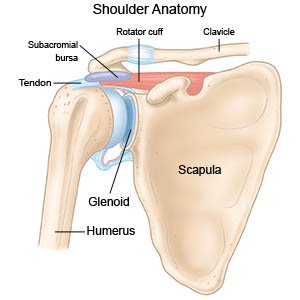Shoulder Pain
Medically reviewed by Drugs.com. Last updated on Apr 6, 2025.
AMBULATORY CARE:
Shoulder pain
is a common problem that can affect your daily activities. Pain can be caused by a problem within your shoulder, such as soreness of a tendon or bursa. A tendon is a cord of tough tissue that connects your muscles to your bones. The bursa is a fluid-filled sac that acts as a cushion between a bone and a tendon. Shoulder pain may also be caused by pain that spreads to your shoulder from another part of your body.
 |
Seek care immediately if:
- You have severe pain.
- You cannot move your arm or shoulder.
- You have numbness or tingling in your shoulder or arm.
Contact your healthcare provider if:
- Your pain gets worse or does not go away with treatment.
- You have trouble moving your arm or shoulder.
- You have questions or concerns about your condition or care.
Drugs used to treat this and similar conditions
Qutenza
Qutenza patches are used to treat neuropathic pain associated with postherpetic neuralgia and ...
Omvoh
Omvoh is used to treat moderate to severe ulcerative colitis or Crohn's disease in adults. This ...
Phenytoin
Phenytoin is an anti-epileptic drug, also called an anticonvulsant. Learn about side effects ...
Capsaicin topical
Capsaicin information from Drugs.com, includes Capsaicin side effects, interactions and indications.
Carbamazepine
Carbamazepine is used to treat epileptic seizures and nerve pain such as trigeminal neuralgia ...
Pregabalin
Pregabalin may be used to treat certain types of pain and used in combination with other ...
Treatment options
The following list of medications are related to or used in the treatment of this condition.
Treatment for shoulder pain
may include any of the following:
- Acetaminophen decreases pain and fever. It is available without a doctor's order. Ask how much to take and how often to take it. Follow directions. Read the labels of all other medicines you are using to see if they also contain acetaminophen, or ask your doctor or pharmacist. Acetaminophen can cause liver damage if not taken correctly.
- NSAIDs , such as ibuprofen, help decrease swelling, pain, and fever. This medicine is available with or without a doctor's order. NSAIDs can cause stomach bleeding or kidney problems in certain people. If you take blood thinner medicine, always ask your healthcare provider if NSAIDs are safe for you. Always read the medicine label and follow directions.
- A steroid injection may help decrease pain and swelling.
- Surgery may be needed for long-term pain and loss of function.
Manage your symptoms:
- Apply ice on your shoulder for 20 to 30 minutes every 2 hours or as directed. Use an ice pack, or put crushed ice in a plastic bag. Cover it with a towel before you apply it to your shoulder. Ice helps prevent tissue damage and decreases swelling and pain.
- Apply heat if ice does not help your symptoms. Apply heat on your shoulder for 20 to 30 minutes every 2 hours for as many days as directed. Heat helps decrease pain and muscle spasms.
- Limit activities as directed. Try to avoid repeated overhead movements.
- Go to physical or occupational therapy as directed. A physical therapist teaches you exercises to help improve movement and strength, and to decrease pain. An occupational therapist teaches you skills to help with your daily activities.
Prevent shoulder pain:
- Maintain a good range of motion in your shoulder. Ask your healthcare provider which exercises you should do on a regular basis after you have healed.
- Stretch and strengthen your shoulder. Use proper technique during exercises and sports.
Follow up with your healthcare provider or orthopedist as directed:
Write down your questions so you remember to ask them during your visits.
© Copyright Merative 2025 Information is for End User's use only and may not be sold, redistributed or otherwise used for commercial purposes.
The above information is an educational aid only. It is not intended as medical advice for individual conditions or treatments. Talk to your doctor, nurse or pharmacist before following any medical regimen to see if it is safe and effective for you.
Learn more about Shoulder Pain
Treatment options
Care guides
- Back Pain
- Fibromyalgia
- Hip Pain
- Musculoskeletal Pain
- Rotator Cuff Injury
- Shoulder Pain
- Viral Syndrome in Children
Medicine.com guides (external)
Further information
Always consult your healthcare provider to ensure the information displayed on this page applies to your personal circumstances.
